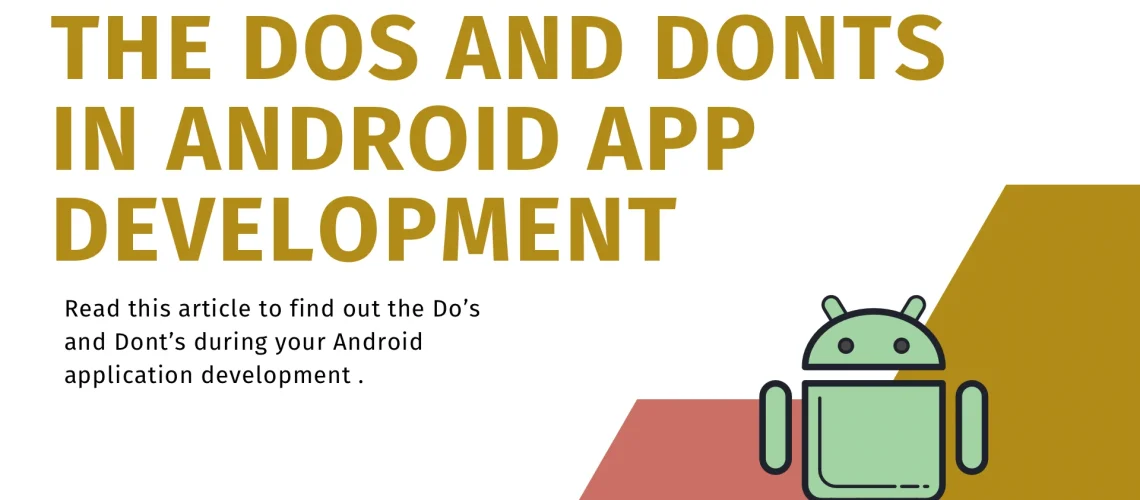Android application development is always iconic. Maybe it’s due to its ease of compatibility across a wide range of devices or its kaleidoscope collection of libraries and tools. While there’s many reasons why you would like to go for an android app rather than an iOS application, there’s few things you need to keep in mind before you go ahead with the project.
Like the metro in Dubai during peak hours, the app market is bustling with too many apps trying to get in. If you want to reach the destination in mind you need to think carefully and follow best practices while developing android apps. Android Share is more than 70% in the app market. What this means for businesses and developers is that every kind of innovative design paired up with a combination of ideas that you’ve already thought of probably exists already. If you’re fishing for a team for your android application development in Dubai and Abu Dhabi, then here’s a few Dos and Don’ts to keep in mind before you get started on the project.
Dos
When developing your android app, or any app for that matter, one important thing to focus on is the user experience. When user experience is promising, everything else comes along naturally, whether your estimated ROI or the budgeted number of mobile app conversions. So how do you make the user experience of your android app is on point?
1. Analyze the Android Design Guidelines
This point is important for many reasons. Android’s popular design principle which is commonly known as material design has a set of guidelines that makes developing an app much easier for the newbies. Material Design has a user-centric focus with accessibility features and guidelines for color schemes, typography and graphics. So following these standard guidelines will ensure that the app has a consistent look and feel, is visually appealing and accessible to all.
2. Reserve Your App’s Name Early
Although reserving a name may not sound as important, it can actually become quite problematic if you don’t. This is because Google’s Android market uses a special package name that is used in your manifest to identify your app amongst other apps existing in the app store. The last thing you need is to find out is that the name isn’t available. Specially after designing the UI and UX with a specific theme and tone. If you’re planning for mobile application development in Dubai and Abu Dhabi it’s better to reserve your name early on.
3. Understand Fragments
Fragments are a reusable portion of a user interface or behavior that can be combined with other fragments within an activity. They are vital to create self-contained UI elements that can be freely reused and rearranged as the situation demands. Some places you can add fragments include your navigation and main window. This will allow you to adapt to various device configuration without the requirement of decoding them. Moreover, fragments can be easily removed or replaced within an activity runtime helping designers create interactive and dynamic UI designs for android apps.
4. Optimize The App
Optimizing the app is another key factor that will determine the success of your android app. Android apps come in a wide range of screen sizes, resolutions, and hardware configurations. Due to its widespread fragmentation, they might not be optimized for all devices. This can cause the app to have inconsistencies in a few devices. This is why it is important to avoid unnecessary elements and objects and optimize for smooth performance and high speed.
5. Use Density-independent pixels instead of Pixels
Using Density-independent Pixels (dp or dip) instead of Pixels (px) allows developers to create apps that have responsive and adaptive user interfaces. Using pixels on the other hand will affect the app because different screens have different pixel densities. So, the same number of pixels corresponds to different physical sizes on different devices causing cross-compatibility issues.
Don’ts
-
Overlooking Security
No matter how many times we say it, security is always going to be top priority. Overlooking this is something that developers should never do. Doing this can not only cause problems to the app owner but also to all its users. There are probably thousands of apps out there. But are they all secure? To secure users’ trust and ensure that the app is completely protected, developers need to put in place proper security measures. These security measure encrypt data and prevent unauthorized access. Infact google play store and other app stores have security guidelines that must be followed. Not following the security guidelines may result in the rejection of the app.
2. Using iOS Design Practices
Sometimes app developers use iOS design principles when creating android apps and this is something you avoid doing. Although it may sound harmless and easy for those who are more familiar with iOS application development, using its principles for android app development can negatively affect the user experience of the android app. Android and iOS apps can be distinguished easily. Using the other’s design principle will harm the distinct familiarity and feel an android app with its own design principle will have.
3. Blocking the Main Thread
The main thread, which is the master thread, handles all the other components in the app and is responsible for many things already. However, one mistake that app developers make during the process is making the main thread handle everything. Including activities that take a long time to execute as well. This will cause the main thread to freeze as it waits for operation that take a long time to finish. When the main thread freezes, it will cause the app to become slow or even unresponsive.





